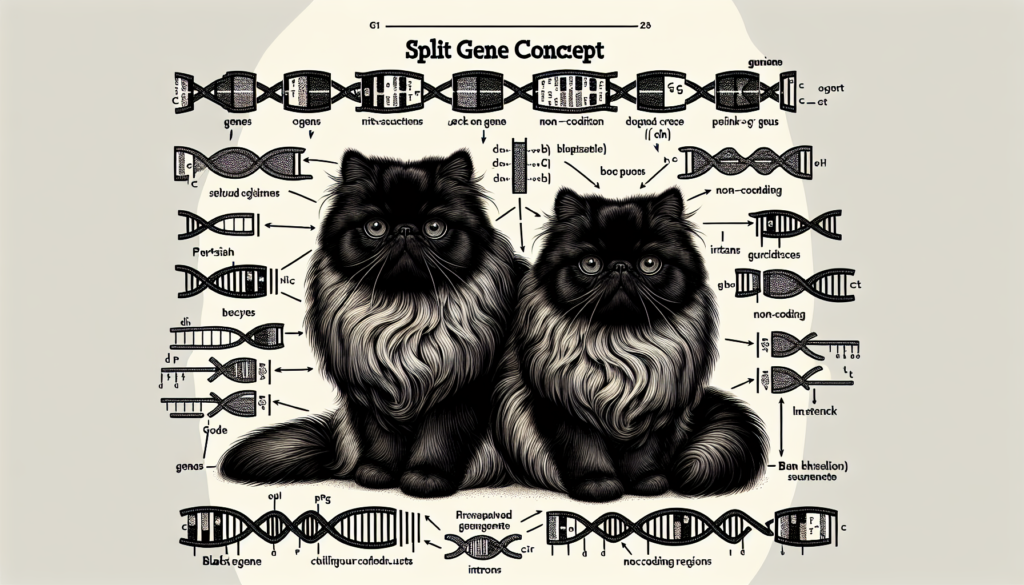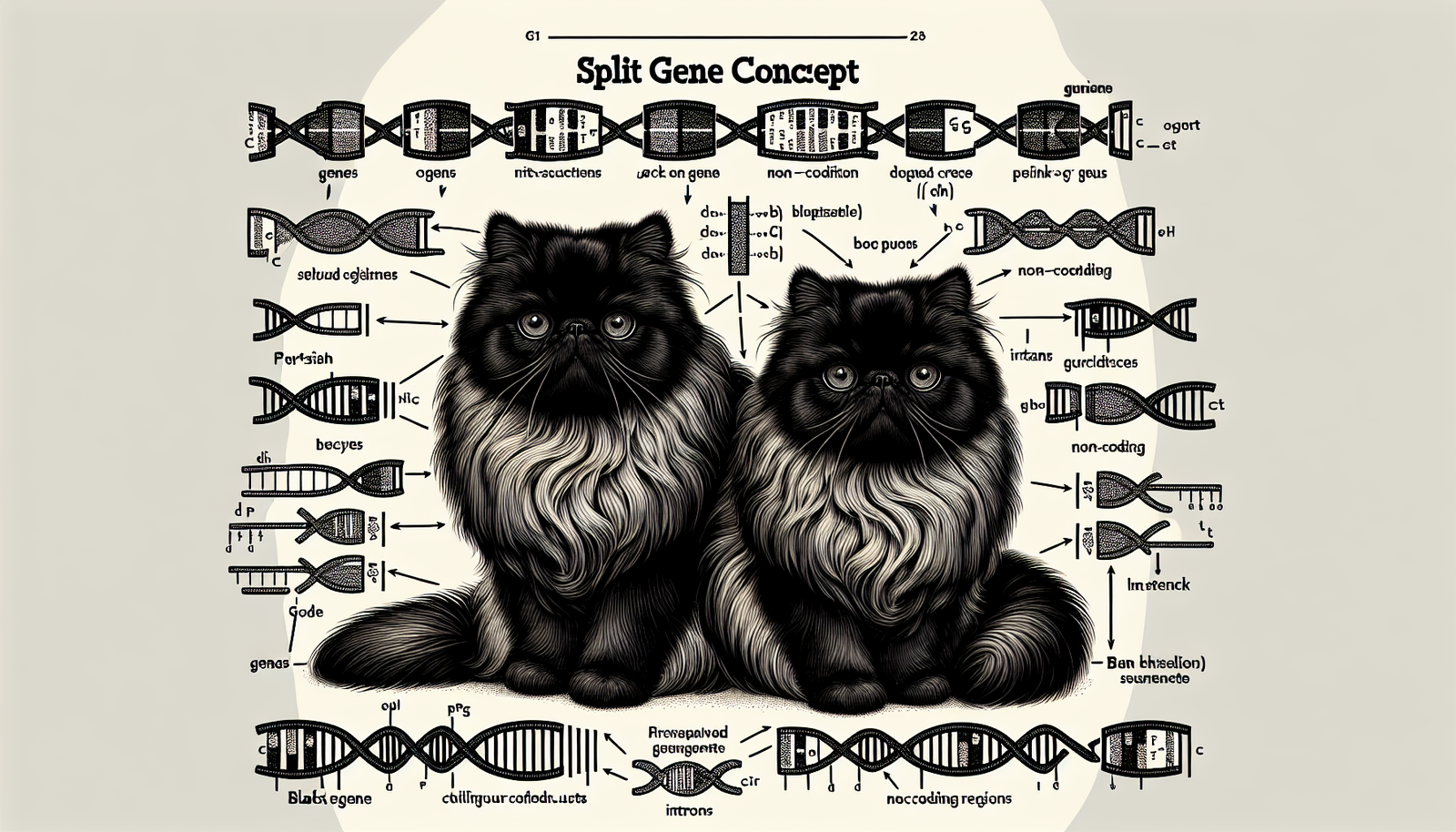Have you ever wondered about the fascinating concept of split genes in black Persian cats? Split genes refer to a unique phenomenon where a gene is not continuous but rather interrupted by non-coding sequences called introns. In the case of black Persian cats, this concept holds particular significance as it contributes to their stunning coat color. In this article, we will journey into the intricate world of split genes and unravel the mystery behind their role in defining the mesmerizing appearance of these beautiful felines. Get ready to explore the enchanting realm of genetics and discover the wonders that lie within the genes of black Persian cats.
Genes in Black Persian Cats
Black Persian cats are known for their stunning beauty and unique characteristics. But have you ever wondered about the role of genes in shaping these traits? In this article, we will delve into the fascinating world of split genes and explore how they influence various aspects of black Persian cats’ lives. From understanding gene structure to the future possibilities of gene therapy, we will cover it all!

Split Genes in Genetics
Before we can fully grasp the significance of split genes in black Persian cats, it is essential to understand the concept of split genes in genetics. Genes, the basic units of heredity, carry information that determines an organism’s traits. Normally, a gene consists of a continuous sequence of nucleotides that code for a specific protein. However, split genes are genes that contain non-coding sections called introns, which interrupt the coding sequences known as exons.
Understanding Gene Structure
To comprehend the role of split genes in black Persian cats, it is crucial to have a solid understanding of gene structure. Genes are made up of multiple exons and introns. Exons contain the necessary information to produce proteins, while introns do not have a direct role in protein synthesis. During gene expression, the introns are removed through a process called splicing, where the exons are joined together to form a functional mRNA molecule.
Introns and Exons in Split Genes
In split genes, introns and exons play a vital role in the coding and expression of genetic information. Introns offer flexibility for genetic evolution and regulation, as they can be alternatively spliced to create unique mRNA molecules. This alternative splicing enables a single gene to produce multiple variants of proteins, increasing the genetic diversity and complexity of an organism. In the context of black Persian cats, the presence of split genes may contribute to their distinctive physical traits and health conditions.
Role of Split Genes in Black Persian Cats
Now that we have explored the basics of split genes, let’s delve into the specific roles they play in black Persian cats.
Gene Expression
Split genes have a significant impact on gene expression in black Persian cats. Through the process of splicing, different combinations of exons can be selected, resulting in the production of distinct mRNA molecules. This alternative splicing allows for the expression of various protein isoforms, which may influence the cat’s physical characteristics, such as coat color or eye shape.
Post-Transcriptional Modifications
In addition to alternative splicing, split genes in black Persian cats undergo various post-transcriptional modifications. These modifications can include the addition or removal of specific chemical groups, such as methyl or acetyl groups, which can alter the gene’s activity or stability. These modifications give rise to different forms of proteins and may contribute to the cat’s unique traits.
Alternative Splicing in Black Persian Cats
Alternative splicing plays a crucial role in shaping the genetic landscape of black Persian cats. By selectively splicing exons, different protein isoforms can be produced, leading to variations in physical characteristics and potentially influencing health conditions or behavioral traits. This flexibility in gene expression allows for greater adaptability and diversity within the black Persian cat population.

Factors Affecting Split Genes in Black Persian Cats
While split genes are an inherent part of black Persian cats’ genetic makeup, various factors can influence their expression.
Inheritance Patterns
In split genes, inheritance patterns can determine which exons are selected during splicing. Certain genetic variations or mutations may affect the splicing process, leading to the expression of different protein isoforms. Understanding these inheritance patterns is crucial for breeders to predict and maintain specific traits within the black Persian cat population.
Environmental Influence
Although genes provide the blueprint for an organism’s traits, the environment can also impact gene expression. Environmental factors such as diet, stress, or exposure to certain substances can influence the splicing process and the subsequent protein products. It is important to consider both genetic and environmental factors when studying the impact of split genes in black Persian cats.
Genetic Mutations
Genetic mutations can have significant implications for split genes in black Persian cats. Mutations may alter the splicing patterns, leading to abnormal protein isoforms or disrupting the proper functioning of genes. Some mutations may even result in genetic disorders, affecting the cat’s physical well-being or behavior. Understanding these mutations can help breeders and veterinarians better diagnose and manage potential health conditions.
Effects of Split Genes in Black Persian Cats
Split genes play a crucial role in shaping various aspects of black Persian cats’ lives, including their physical traits, health conditions, and behavioral characteristics.
Physical Traits
The presence of split genes contributes to the unique physical appearance of black Persian cats. These genes determine characteristics such as coat color, eye color, and facial structure. Different combinations of exons result in variations in protein isoforms, giving rise to distinct physical traits that set black Persians apart from other cat breeds.
Health Conditions
Split genes can also influence the susceptibility of black Persian cats to certain health conditions. Genetic mutations affecting the splicing process can lead to the production of abnormal proteins or the absence of essential proteins, resulting in various disorders. For example, certain mutations in split genes have been associated with conditions such as polycystic kidney disease or hypertrophic cardiomyopathy in black Persian cats.
Behavioral Characteristics
Beyond physical traits, split genes may also contribute to the behavioral characteristics of black Persian cats. Variations in protein isoforms due to alternative splicing can influence neurotransmitter receptors or signaling pathways in the brain, potentially impacting aspects such as temperament, sociability, or intelligence.
Genetic Testing for Split Genes in Black Persian Cats
Advancements in genetic research have opened up avenues for testing and understanding split genes in black Persian cats.
Analyzing DNA Sequences
Genetic testing for split genes involves analyzing the cat’s DNA sequences. By sequencing specific genes of interest, such as those involved in coat color or health conditions, researchers and breeders can identify variations or mutations that may impact the splicing process. This information can aid in predicting and managing potential traits or health risks in black Persian cat populations.
PCR and Amplification Techniques
PCR (Polymerase Chain Reaction) and amplification techniques are commonly used in genetic testing for split genes. These techniques allow researchers to amplify specific regions of DNA and examine the variations or mutations present. PCR-based methods enable the detection of specific genetic changes associated with alternative splicing patterns or disease-causing mutations.
Genomic Profiling
Genomic profiling involves studying the entire genome of black Persian cats to gain a comprehensive understanding of their genetic makeup. This approach allows researchers to identify not only specific split genes but also potential interactions between various genes and their impact on the overall phenotype of a black Persian cat.
Understanding the Importance of Split Genes in Black Persian Cat Breeding
The knowledge of split genes in black Persian cat breeding has several implications for breeders and enthusiasts.
Selective Breeding Strategies
Understanding split genes enables breeders to make informed decisions when selecting parent cats. By considering the specific exons and protein isoforms associated with desirable traits, breeders can focus on pairing cats with compatible genetic profiles, increasing the chances of passing on desired physical characteristics or reducing the risk of passing on health conditions.
Quality Assurance in Breeding Programs
Knowledge of split genes allows breeders to implement quality assurance measures in their breeding programs. By using genetic testing, breeders can identify specific variations or mutations that may impact the splicing process and subsequently influence the cat’s traits or health. This information enables breeders to make responsible and ethical breeding decisions.
Implications for Breed Standards
The understanding of split genes in black Persian cats can also have implications for breed standards. Breed standards typically define the specific physical characteristics or traits that are desired in a particular breed. By considering the influence of split genes on these traits, breeders and breed associations can reassess and refine breed standards to reflect the genetic makeup of black Persian cats more accurately.
Preventing Genetic Disorders Associated with Split Genes in Black Persian Cats
To ensure the well-being of black Persian cats, steps can be taken to prevent and manage genetic disorders associated with split genes.
Careful Selection of Parent Cats
One of the essential measures for preventing genetic disorders is the careful selection of parent cats. By thoroughly assessing the genetic profiles of potential parents and considering their split gene variations, breeders can minimize the risk of passing on detrimental genetic mutations. This thoughtful selection process helps preserve the health and quality of the black Persian cat population.
Health Screening Programs
Health screening programs are crucial for identifying potential health conditions associated with split genes. Regular examinations, genetic testing, and screening for specific disorders can aid in early detection and intervention. By implementing comprehensive health screening programs, breeders and veterinarians can work together to maintain the well-being of black Persian cats.
Evaluating Offspring’s Health
After breeding black Persian cats with known split gene variations, evaluating the health of their offspring becomes paramount. Thorough health assessments, including physical examinations, laboratory tests, and genetic screening, can help identify any potential health issues that may arise due to split gene mutations. Regular monitoring of the offspring’s health is essential for ensuring their overall well-being.
Future Perspectives on Split Genes in Black Persian Cats
As scientific research progresses, new discoveries and advancements in genetic research hold promise for understanding and managing split genes in black Persian cats.
Advancements in Genetic Research
Ongoing advancements in genetic research technologies and techniques will continue to shed light on the intricate mechanisms of split genes. With improved tools for DNA analysis, researchers can delve deeper into the complexity of alternative splicing patterns and their implications for black Persian cats. These developments will contribute to a more comprehensive understanding of split genes and their impact on various traits.
Gene Therapy Possibilities
The advancements in genetic research also offer potential avenues for gene therapy in black Persian cats. Gene therapy involves manipulating genetic material to treat or prevent diseases. As our understanding of split genes deepens, it may be possible to develop targeted therapies for genetic disorders associated with alternative splicing abnormalities. This could revolutionize the way we approach the prevention and management of inherited conditions in black Persian cats.
Ethical Considerations
While the possibilities offered by genetic research and gene therapy are exciting, it is important to address ethical considerations throughout these developments. Ensuring the responsible and ethical use of genetic information and technology is essential to preserve the well-being and diversity of black Persian cats. Ethical guidelines and regulations must be in place to guide these scientific endeavors in a compassionate and responsible manner.
Conclusion
In conclusion, split genes play a significant role in shaping the remarkable traits of black Persian cats. Understanding the complexities of split genes provides valuable insights into their physical characteristics, health conditions, and behavioral patterns. Through genetic testing, selective breeding strategies, and responsible management, breeders and enthusiasts can work towards preserving the unique charm and well-being of black Persian cats. As genetic research continues to progress, the future holds immense possibilities for unraveling the mysteries of split genes, leading to new advancements in the field of feline genetics.

